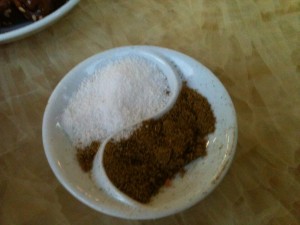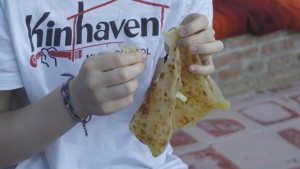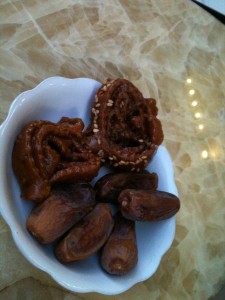It seems a long time ago, now, but our first meal in Morocco, the day we arrived, was f’tur or if’tar, the traditional breaking of the Ramadan fast. Kevin Smith, the generous colleague who loaned us his house while he and his family were away, walked us through the process. First we waited for the magic hour of the Isha prayer to arrive (the 5th prayer of the day, 7:38 p.m. or thereabouts); then we wandered into town and found a table at a restaurant where we sat and waited some more, this time in company with everyone at the surrounding tables, for the actual call to prayer. A waiter brought us a platter of dates, candied pastries,
and boiled eggs to sprinkle with cumin and salt, even before the call to prayer sounded. 
We stared at the waiting food, talking but also listening hard through the talk. With the call to prayer, dates began to vanish at tables all around the restaurant; egg-shells were cracked and peeled almost in unison.

After this kind of first course, the waiter brought us fried flatbread (rghaif or milhoui) and a kind of spongy bread (bghrir) to drizzle with honey, and harira (spicy lentil soup with a mutton base, so we had vegetarian “potage” instead).

Delicious!
Even this first meal emphasized for me the communal aspect of Ramadan in Morocco. How different it must feel to be Muslim in the United States, fasting in community, surely, with other Muslims, but not with an entire country behind you. So here’s a geeky thought for you: Canadian Benedict Anderson famously claimed that nations are imagined communities constructed by (for instance) being able to imagine everyone else reading the same newspaper at the same moment. But how much more powerful a communal experience this simultaneous meal creates! Ramadan seems to me to be defined by both fasting and f’tur; both the fast and its conclusion incorporate—communally embody—a kind of social unanimity. I can’t imagine having this same experience of communal identity in the United States. Except maybe at Thanksgiving!
